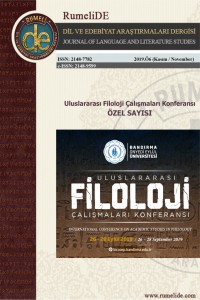Öz
In an interview with
Francis Gertler , Patrick McGrath proposes that there
has been very few written about “the revival of fascism in England immediately
after the war” and that he cannot explain why this is so. And thus he published
The Wardrobe Mistress in order to
explore the reasons for the return of the fascism after the end of World War
II. Although at a first glance the novel appears to be surrounded by gothic
props such as the uncanny return of the dead body, the dark and gloomy setting,
the reader is also concerned about its handling with anti-Semitism, as the main
character is a Jew and her dead husband was a strong Nazi sympathizer. Thus, in
addition to its Gothic traits, the novel transmits a political message about
fascism in a gothic sensibility. By implementing the gothic genre’s traditional
uncanny element into a political arena, McGrath proposes that fascism is also
similar to the dead bodies which continues to reappear in a more tormenting
way. Therefore this paper will present McGrath’s parodic relation with the
Gothic genre, which he labels as “new gothic” in order to explore the novel’s
representation of anti-semitism by ironically juxtapositioning a dead Nazi soul
and a living Jewish body.
Anahtar Kelimeler
Kaynakça
- Dupont, J. (2013). Patrick McGrath: Directions and Transgressions. Newcastle-Upon-Tyne: Cambridge Scholors Press. Freud, S., Gay, P. (1995). The Freud Reader. London: Vintage. Gertler, F. (n.d). The Greek Chorus, Dybbuks and the Resurgence of Fascism. Retrived 4, 2019 from https://www.foyles.co.uk/author-patrick-mcgrath. McGrath, P., Bradford, M. (1993). The New Gothic: A Collection of Contemporary Gothic Fiction. London: Picador. McGrath, P. (2017). The Wardrobe Mistress. London: Hutchinson. Menegaldo, G. (1997, November 5). Interview to Patrick McGrath. Sources. Weissman, G. (2004). Fantasies of Witnessing: Postwar Efforts to Experience the Holocaust. Ithaca and London: Cornell University Press. Zlosnik, S. (2011). Patrick McGrath. Cardiff: University of Wales Press.
Öz
Francis Gertler ile yaptığı röportajda, Patrick
McGrath “savaştan hemen sonra faşizmin İngiltere’de tekrar ortaya çıkması” hakkında çok az yazıldığını ve bunun neden böyle olduğunu
açıklayamadığını söylemiştir. Bu yüzden de 2017 yılında The
Wardrobe Mistress adlı romanı yayınlamıştır ve
romanda özellikle faşizmin aslında hiç bitmediğini ve sessizce nasıl geri
döndüğünü anlatmıştır. Her ne kadar ilk bakışta roman, ölü bir bedenin
esrarengiz bir şekilde ortaya çıkışını, karanlık ve kasvetli yer
ve zaman gibi gotik elementler ile donatmış olsa da, okuyucu aynı zamanda
romanın anti-Semitizm’i nasıl ele aldığını da görmektedir. Romanın
anti-semitizm örgüsü, ana karakterin bir Yahudi olması ve ölen kocasının daha
sonradan öğrendiği kadarı ile bir Nazi sempatizanı olduğu ortaya çıkmıştır ve
böylelikle roman, Gotik elementlerinin yanı sıra, gotik bir yaklaşımla politik bir mesaj da aktarmaktadır. Burada görülen şudur ki,
gotik edebiyatın en önemli temalarından biri olan “bastırılmışın geri dönmesi”
olarak tanımlanan tekinsizlik konusu, bu sefer savaştan sonra bastırılmış olan
faşist ideolojinin sessizce ama daha yıkıcı bir şekilde geri döndüğüdür. Sonuç
olarak bu makalede, ölü bir Nazi ruhu ile yaşayan bir
Yahudi bedenini nasıl ironik bir şekilde bir araya getirerek
anti-Semitizm’i işlediğini gösterebilmek adına McGrath’in “yeni gotik” olarak adlandırdığı gotik türüyle olan parodik ilişkisi
incelenecektir.
Anahtar Kelimeler
Kaynakça
- Dupont, J. (2013). Patrick McGrath: Directions and Transgressions. Newcastle-Upon-Tyne: Cambridge Scholors Press. Freud, S., Gay, P. (1995). The Freud Reader. London: Vintage. Gertler, F. (n.d). The Greek Chorus, Dybbuks and the Resurgence of Fascism. Retrived 4, 2019 from https://www.foyles.co.uk/author-patrick-mcgrath. McGrath, P., Bradford, M. (1993). The New Gothic: A Collection of Contemporary Gothic Fiction. London: Picador. McGrath, P. (2017). The Wardrobe Mistress. London: Hutchinson. Menegaldo, G. (1997, November 5). Interview to Patrick McGrath. Sources. Weissman, G. (2004). Fantasies of Witnessing: Postwar Efforts to Experience the Holocaust. Ithaca and London: Cornell University Press. Zlosnik, S. (2011). Patrick McGrath. Cardiff: University of Wales Press.
Ayrıntılar
| Birincil Dil | İngilizce |
|---|---|
| Konular | Sanat ve Edebiyat |
| Bölüm | Türk dili, kültürü ve edebiyatı |
| Yazarlar | |
| Yayımlanma Tarihi | 21 Kasım 2019 |
| Yayımlandığı Sayı | Yıl 2019 RumeliDE 2019.Ö6 - Bandırma Onyedi Eylül Üniversitesi Uluslararası Filoloji Çalışmaları Konferansı |


